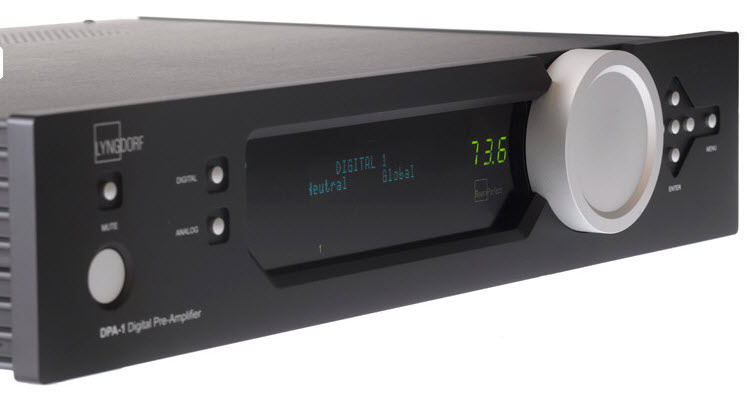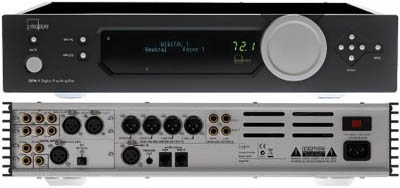Lyngdorf Audio DPA-1 Digital Preamplifier
| Lyngdorf Audio DPA-1 Digital Preamplifier |
| Imagine the Ideal Listening Room |
|
|
|
October, 2011 |

I have one of those long narrow rooms (14’x30′) with a vaulted ceiling and openings to the foyer, hallway, 2nd floor stairs, and kitchen (the openings are all along one long wall). The listening sofa is across from the stairs about 10′ back from the plane of the speakers and faces the front of the house. Luckily the room is carpeted, but as one might imagine, this room configuration is far from ideal. Still, it is not nearly as poor as some rooms I’ve visited.
The main problems are a low bass dip followed by a 125Hz mid-bass rise of about 6dB and a region of brightness somewhere between 2.5kHz and 4kHz. Since this is essentially our living room, my wife does not want me to put copious room treatments around the room and I believe that taming that 6dB mid-bass peak would be difficult to do with conventional passive bass traps.
So until now, I’ve made the room work by employing basic analogue equalization and making the adjustments by ear. This resulted in very good imaging and performance, that is quite close to the sound one would expect in a room with good acoustics—yet not quite “perfect” (as if there were such a thing).
One day, I began researching information on the different consumer-oriented digital room correction devices. From experience, I’ve come to understand that “perfectly-flat-response,” from 20Hz to 20kHz is not only impossible for many systems to achieve, but intolerably bright sounding when it can be done.
I found that Tact’s bent was for basically flat response and that it is not the most user-friendly type of room correction on the market. DEQX is reputed to be very good, for those technical-oriented persons who can figure out how to make it perform to its full potential. And then I came to Lyngdorf Audio, which is an offshoot from TacT but is simpler to set up and operate and employs its own algorithms that are not designed to be “flat,” but rather to take the room out of the equation and allow your speakers sound the way the designer intended.
Description
The subject of this review is the Lyngdorf Audio DPA-1, which was introduced in 2007 but is still current and will be for some time. The DPA-1 is a digital preamplifier that also offers “RoomPerfect” room correction, an excellent DAC, and a digital bass crossover that can be programmed for just about any crossover point with user-selectable Butterworth or Linkwitz-Riley filter types.

The DPA-1 incorporates both balanced (XLR) and unbalanced (RCA) analog inputs (one pair and three pair respectively) and five digital inputs including three coaxial RCA-type S/PDIF, one AES/EBU, and one Toslink optical input. There is also a balanced microphone input and a 12-volt trigger for powering up other linked gear.
The Lyngdorf comes with a calibrated microphone and mic stand. It also comes with a 24’ balanced microphone cable, remote control, and basic black AC power cord. The DPA-1 is delivered preloaded with the latest firmware and can be updated online via computer if and when new firmware is released. Mine is loaded with Version 2.1.
Setting up
I had a little difficulty entering the setup menu for the first time. It seems I was intuitively pressing the “Menu” and “Info” buttons when I should have simply pushed in the Power button on the main unit and then hit “Enter” on the remote. That’s what I get for not reading the directions! Another thing I had to remember was that when you put the DPA-1 in “Stand-by” from the remote, to turn it back on all you do is hit the “Enter” button. Once I figured that out things went a lot smoother.
When the DPA-1 is turned on for the first time it takes you to the RoomPerfect Guided Setup Menu where it prompts you to plug in the microphone and put it in the initial “Focus” position (between where your ears would normally be when listening). Next you are prompted to adjust the testing volume and, I believe, I saved my test volume at “67.” You are then guided through taking a series of microphone measurements throughout the room. The DPA-1 will tell you if a particular take is successful and you have the option to save the measurements or not. In my large room, it was easy for me to accumulate between 98% and 100% “room knowledge,” and that’s the area to shoot for.
When I was done taking the first group of measurements the Lyngdorf became operational and sounded very good right out of the gate. But later, I added six additional “Focus” positions, some with my outboard Walsh-type tweeters, and some without. What this accomplished was to give me a deluxe assortment of additional subtle voicing options. You can take Focus measurements away from the usual sweet spot if you like, but what I did was to take the Focus measurements in my exact listening position and then up a little higher and then a few feet further back on the same axis. And this gave me subtly different voicings in my usual sweet spot.
Between the six preprogrammed curves and up to nine additional ”Focus” positions the user can input (including “Global”), one can pretty-much tailor any given recording to sound its best at the touch of a button. What could be cooler than that!
That said, you don’t have to use all the extra positions although I wound up using seven (and an additional global position is derived from those), but my system is not the norm with the extra add-on tweeters. However, the more positions you add the more voicing options you’ll have. And you need not do this on your first pass as other Focus and/or Global listening positions can be measured and added to memory later when you’re in the mood.
Being a bit of a perfectionist, I got very good results the first time, although later I discovered my add-on 360-degree tweeters were actually connected in the wrong polarity during my initial measurements. I decided to delete the original measurements and re-do the setup. Curiously, the second pass resulted in sound that was a bit too bright, so I deleted it from memory and made a third attempt trying to recall my microphone positions from the first pass that gave the better results. Anyway, my third time was the charm and my diligence paid off big time as this resulted in the best voicing options yet. From this I have to conclude that the microphone locations you choose will definitely affect the sonic results. Lyngdorf is fond of suggesting that you put the microphone in random spots throughout the room, but of course that is quite vague and leaves the user with lots of latitude for experimentation.
Initial discovery
The first thing I noticed about the Lyngdorf sound was that it was very sweet and smooth and it delivered more bass than I thought it would. In fact, on some recordings with very strong mid bass, it was a bit too much. I e-mailed Lyngdorf about this and they confessed that their “Neutral” voicing may actually be a tad pumped up in the bass because it simulates room gain. “Very interesting” I mused. They further confided that their “Open” voicing is actually more neutral because it does not factor in room gain. Hmmm…
So I tried the “Open” setting on those CD’s that had too much bass and Violá, it worked perfectly and delivered a more realistic bass perspective for my select bass-heavy recordings. Your individual results may vary.
Of Awe and Ecstasy One particular day, I decided to play Ridrigo y Gabriela’s11:11 CD [ATO 00080]. I have played this CD on different systems and on different configurations of the same system and you never quite know what to expect from it. Rodrigo y Gabriela are known for their blazing string speed and also for their interwoven harmonies. So here we have a very dynamic recording with a lot of bite on the fast string plucking and guitar-body percussion combined with some very beautiful melodic passages. In my experience it appears to be difficult for a given system to play the music back with just the right amount of percussive bite while also serving the sweetness of the melody.
One particular day, I decided to play Ridrigo y Gabriela’s11:11 CD [ATO 00080]. I have played this CD on different systems and on different configurations of the same system and you never quite know what to expect from it. Rodrigo y Gabriela are known for their blazing string speed and also for their interwoven harmonies. So here we have a very dynamic recording with a lot of bite on the fast string plucking and guitar-body percussion combined with some very beautiful melodic passages. In my experience it appears to be difficult for a given system to play the music back with just the right amount of percussive bite while also serving the sweetness of the melody.
As it turned out, with the many voicings programmed into my Lyngdorf I could have my cake and eat it too. This meaning that by pushing different voicing buttons I could tailor the sound for my optimal blend of bite versus melody. It was actually uncanny how subtly I could tailor this CD to give me exactly the effect I was looking for. I would be remiss in my duty if I neglected to mention that in addition to this wonderful ability to subtly tailor recordings, the Lyngdorf provided the most musical nuances and high-frequency detail that I’ve ever heard come out of my speakers.
Moreover, vocals and midrange instruments sounded fantastic. I was amazed by the vocal harmony on CD’s like The Austin Lounge Lizard’s Paint Me on Velvet [Flying Fish FF 70618]. Of particular note was the song “Put the Oakridge Boys in the Slammer,” where the vocal harmony and the distinct character of each male voice was captured to perfection.
 Then on Devil Doll’s Queen of Pain CD [LB 73333-2], Colleen Duffy’s sultry vocals were quite immediate and entrancing while the drum kit hammered out the rhythm and the cymbals shimmered like frosted sparks. I felt like I could see clear down Ms. Duffy’s throat even with my eyes closed.
Then on Devil Doll’s Queen of Pain CD [LB 73333-2], Colleen Duffy’s sultry vocals were quite immediate and entrancing while the drum kit hammered out the rhythm and the cymbals shimmered like frosted sparks. I felt like I could see clear down Ms. Duffy’s throat even with my eyes closed.
I was a bit reluctant to connect my turntable system into the Lyngdorf due to the extra A to D conversion involved, but my fear proved to be unfounded. The Lyngdorf DPA-1 delivered ultra detail with clear extended highs and the most grainless midrange performance a ‘phile could hope for. I believe I was using the “Open” voicing for most of my records as that setting usually resulted in the more linear and articulate bass performance. I never had so much fun playing through some of my old classic albums from groups like the “Talking Heads,” and the “B 52’s.”
The highs seemed to reach out to infinity and on Cameo’s 12-incher of “Back and Forth” I was able to hear all the little things being said in the background that I never knew existed until the Lyngdorf made it clear—literally!
Caveats
Since the DPA-1 was designed roughly five years ago it lacks a USB input. It is my understanding that the Lyngdorf’s digital inputs can accept resolutions up to 24-bit/192kHz but that its internal processing is performed at 24-bit/96kHz.
In actual use, this did not seem to matter in that even my vinyl records sounded wonderfully detailed and musical. And if a USB input is a necessity, one can purchase a simple USB adapter such as the Musical Fidelity V-Link, which is fairly inexpensive and works very well.
Lyngdorf did tell me that in all likelihood their future upscale room correction components will offer USB digital inputs, although that is still a bit down the road.
Summary
Frankly, I am amazed at what the Lyngdorf DPA-1 accomplished in my room. With its many analog and digital inputs, plus the remote control and its myriad voicing options, it has all the flexibility that most audiophiles would ever desire. I was also pleased that the Lyngdorf sounded so sweet and smooth that I did not feel compelled to find a way to add tubes to the electronics chain.
Not only did the DPA-1 make my system better balanced, more nuanced, and more musical, but it provided depth and imaging to die for. And it accomplished all this without the need for expensive aesthetically-invasive room treatments. That said, in some very poor rooms it might be a good idea to help the Lyngdorf work its magic by adding some acoustic padding in the most problematic areas.
My belief is that the reason for the Lyngdorf’s superior clarity and its ability to expose musical nuances previously unheard is due to its ability to effectively neutralize room reflections that would ordinarily mask details and smear the vocal and instrumental images. In other words, you may have the highest resolution source material and equipment known to man, but if your room acoustics are not top-notch and/or you lack competent digital room correction, the level of resolution you will hear at your listening seat will be far from the level of resolution your system is capable of providing. I can attest that adding the DPA-1 to my system has improved its musical performance and its resolution much more than any other tweak or component in my experience.
In my estimation, for those of us with less than perfect rooms (probably 98 percent of us) the Lyngdorf DPA-1 is not only a very desirable piece of gear—it is essential. Accordingly, I bought the review sample, for how could I not! Very strongly recommended!

![]()
Description
Lyngdorf Audio DPA-1 Digital Preamplifier with RoomPerfect room correction
Power consumption: 4 watts (Standby mode)
Power consumption: 35 watts (Operate mode)
Width: 450mm / 17.72 inches
Depth: 355mm / 13.98 inches
Height: 100mm / 3.94 inches (including feet)
Net weight: 7.4 Kg / 16 lbs.
Price: $5700 USD (approximate)
Please visit www.lyngdorf.com for more information on specs and features.
Manufacturer
Lyngdorf Audio
Ulvevej 28
7800 Skive
Denmark
Phone: +45 9614 5600
Fax: +45 9614 5601
Website: http://www.lyngdorf.com
e-mail: info@lyngdorf.com
![]()
Don’t forget to bookmark us! (CTRL-SHFT-D)
Stereo Times Masthead
Publisher/Founder
Clement Perry
Editor
Dave Thomas
Senior Editors
Frank Alles, Mike Girardi, Russell Lichter, Terry London, Moreno Mitchell, Paul Szabady, Bill Wells, Mike Wright, and Stephen Yan,
Current Contributors
David Abramson, Tim Barrall, Dave Allison, Ron Cook, Lewis Dardick, John Hoffman, Dan Secula, Don Shaulis, Greg Simmons, Eric Teh, Greg Voth, Richard Willie, Ed Van Winkle, Rob Dockery, Richard Doran, and Daveed Turek
Site Management Clement Perry
Ad Designer: Martin Perry





Be the first to comment on: Lyngdorf Audio DPA-1 Digital Preamplifier